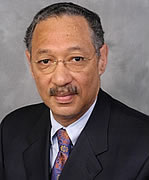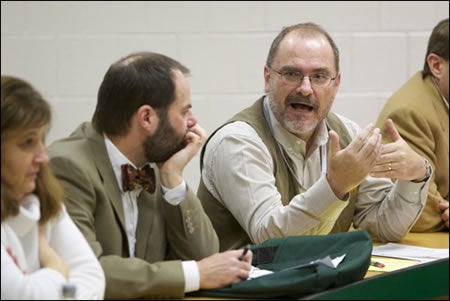Faculty: Reorganization offers opportunities, hazards
Many faculty and staff members at East Carolina University say they are struggling to see the benefits of a possible academic reorganization. At the Brody School of Medicine, however, some see opportunities. 
“What could we create that’s better?” asked Dr. Paul Cunningham, dean of the Brody School of Medicine, during a Thursday forum attended by members of the ECU Program Prioritization Committee. That group is meeting with university schools and colleges to hear faculty and staff responses to its recent report outlining possible changes to ECU’s organizational structure and elimination or modification of various units and degree programs.
A white paper released Feb. 15 by the chancellor-appointed PPC presents 57 options for reorganization at the divisional, college and departmental levels. Some would have a broad impact, such as consolidation of all colleges within one academic division, while others are more focused, such as moving individual departments to different colleges.
Dr. Suzanne Lea, a faculty member in the Department of Public Health at the medical school, said some of the departments listed for reorganization in the committee report are part of the five core disciplines of a school of public health: biostatistics, epidemiology, environmental health science, health policy and management, and social and behavioral sciences. Bringing them into the medical school could help lead to the creation of a public health school at ECU.
Merging the Division of Research and Graduate Studies into other divisions met opposition at Brody, which brings in a significant portion of the university’s research funding. Faculty members also opposed combining the Brody basic science programs into a single biomedical science program.
Dr. Phyllis Horns, vice chancellor for health sciences and a member of the PPC, said the programs are regularly on the University of North Carolina system “list of low-performing programs,” due to their small number of graduates. Combining them would be one way to improve the numbers.
“The other approach is to make the school four times bigger,” Cunningham said.
At the ECU College of Nursing, faculty and staff members largely opposed taking on other departments, such as social work and nutrition. They want to collaborate with those programs but don’t want to take on non-nursing departments or have departments on main campus.
“We need to send a message that we want to be a College of Nursing, and that’s what we want to be,” Dr. Martha Engelke, associate dean, said to applause.
The College of Allied Health Sciences Administrative Council, made up of chairs of each of the eight departments of the college, recommended no significant modifications to existing structures.
In two forums, concerns ranged from the cost effectiveness of merging divisions or departments, to space constraints that create orphan departments from dissolved colleges across campus, to how changes would affect visibility, donor/alumni giving and collaborative research already underway.
Merging physician assistant studies and clinical lab sciences or occupational therapy and physical therapy can’t occur due to accreditation standards and restrictions that require distinct separation of programs, budgets, directors and coursework.
“Although we share the term ‘therapy,’ there are a lot of things we don’t share,” said Dr. Walter Jenkins, chairman of physical therapy.
While nutrition or health and human performance could be natural fits with allied health sciences, there is no space in the Health Sciences Building for those programs.
Another suggestion to move physician assistant studies and clinical laboratory science to the Brody School of Medicine might work physically, but the programs would have to remain separate due to accreditation, curriculum and other reasons. P.A. students take the same classes as medical students but at a faster pace due to the length of the program, so they wouldn’t be able to share the same lectures.
The majority of allied health sciences programs are at the graduate level, and having an independent graduate school is helpful, faculty members said. Keeping a health sciences division is important due to the unique nature of the division, which operates clinics providing health care to the public.
Elsewhere on campus, comments at the forums were similar.
“Well-meaning reorganization can paralyze a campus for years,” said Dr. Glen Gilbert, dean of the College of Health and Human Performance. “I’ve seen that.”
Many who spoke at the forums asked why the university is considering change.
“We’re not going to disrupt this university for no good reason,” said committee chair and geography professor Dr. Ron Mitchelson, adding that some moves improve academic quality at ECU. “It doesn’t hurt to look at who we are and what we are doing.”
Chancellor Steve Ballard formed the committee last May and asked its 13 members to identify opportunities for long-term reallocation of university resources, prompted in part by continuing fiscal challenges. ECU took a 16.1 percent budget cut in state funding for the 2011-2012 fiscal year following four consecutive years of state budget cuts.
No estimate of savings
Although cost savings have not been assessed, Mitchelson said at several forums that the greatest savings would come at the administrative level and likely mean the displacement – over time – of administrative employees. For example, he said his figures show dissolving a school would save approximately $250,000 per year.
At one forum, Horns spoke of the “human toll” in terms of stress created during the process and the potential elimination of positions.
Moving individual departments may not save any money, Mitchelson said at several forums, but could improve a program. And he noted more than once that one option is to leave the academic structure as it stands.
‘Not knowing’ a concern
A detailed breakdown of potential savings will be released by March 30 and submitted to Ballard along with several specific scenarios for reorganization. The committee will take opinions of faculty and staff into account while crafting those.
Until then, some faculty feel caught in limbo.
“It’s the not knowing that’s making it so hard to plan,” Dr. Susan Ganter, chair of mathematics, science and instructional technology said at the College of Education forum.
The committee continues to receive feedback electronically via surveys emailed to faculty and staff. That outlet remains open through March 9. A faculty senate meeting to discuss the PPC white paper is scheduled for March 20.

Geography professor Dr. Ron Mitchelson, right, speaks at a recent PPC forum on main campus. Mitchelson is chair of the committee that has been investigating the potential reorganization scenarios. Photo by Cliff Hollis